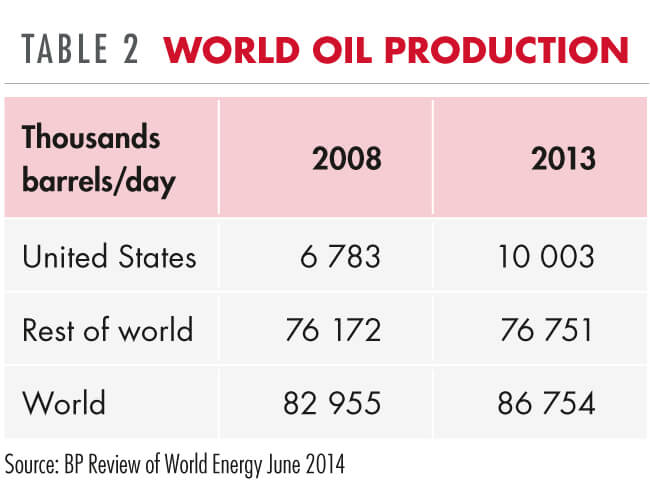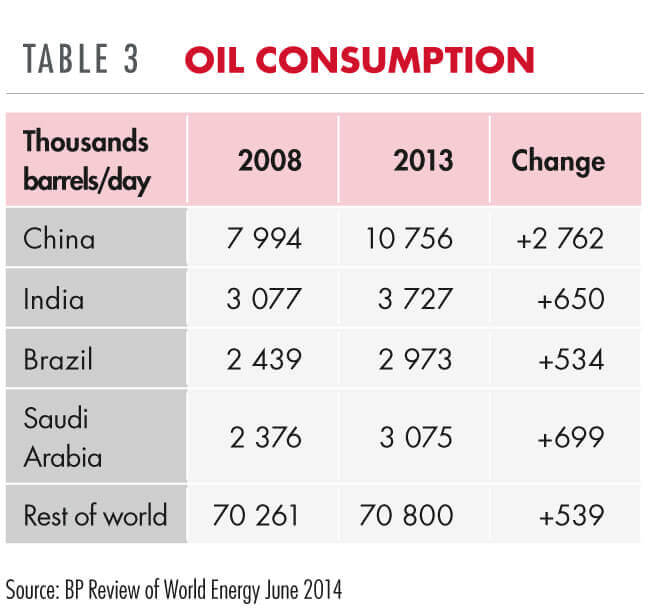The dramatic collapse of oil prices at the end of last year caught most market participants by surprise. For three and a half years, between February 2011 and August 2014, Brent crude oil traded in a stable price range, averaging US$110 per barrel (/bbl). Investors, producers and consumers came to accept that US$100/bbl was an appropriate price for planning purposes. As recently as 19 June 2014, Brent closed at US$114.94/bbl. However, prices then began to fall at an ever-increasing pace until, in January, oil broke through US$50/bbl.
When viewed in retrospect, the sequence of events which precipitated the price collapse seems to have a compelling logic. Sandy McGregor discusses the interaction of two very significant developments: a technical revolution in the production of oil and the economic slowdown in emerging markets, especially in China.
The fracking revolution
Historically, almost all oil production has come from porous rocks, which allow oil to be captured in subterranean reservoirs. Oil exploration involves finding such reservoirs and oil production involves drilling into them to extract their contents.
Large amounts of oil and gas are also trapped in less porous shales. Fracking is the technical game changer, which allows these previously inaccessible resources to be profitably exploited. The United States enjoys a combination of factors that have allowed this new technology to be deployed at astonishing speed - an abundance of entrepreneurial initiative, mineral rights in private ownership, a well-developed petroleum infrastructure and a favourable tax regime.
Prior to 2008 there was much talk about 'peak oil', the proposition that, as a consequence of resource depletion, it would no longer be possible to increase oil production significantly. Thanks to fracking, US oil production, which had been in decline for many years, started to increase in 2009, as shown in Table 1. This has led to growth in overall global oil production (see Table 2), despite static conventional oil production. The fracking revolution has silenced the proponents of peak oil.


The slowdown in developing markets
As a general rule it is always a slowdown in demand which precipitates a price collapse, and recent events in the oil market are no exception. Initially, rising production in the US was easily absorbed by growing demand in emerging markets. Indeed, the fact that the price remained above US$100/bbl for so long is evidence that the oil industry was finding it difficult to meet the needs of these rapidly growing economies. Growth in China, India and Brazil accounted for the majority of the increase, as shown in Table 3. Consumption in the developed economies declined.

In the past two years the great emerging market boom has come to an end, and there has been a significant decline in the growth rates of these countries. In particular, Chinese growth has slowed. The great surge in investment spending, which created the biggest commodity boom ever, is abating. Commodity prices are declining. Oil held up for longer than other commodities but it too has succumbed to the consequences of demand growth declining when supply is increasing. Table 4 highlights the downward trend. With demand growing much more slowly than supply, a price collapse became inevitable.

What happens next?
There is an old adage in commodity markets that what ends high prices is high prices and what ends low prices is low prices. In response to changing circumstances, producers and consumers change their behaviour. This process takes time. History teaches us that for most metals and minerals this can take more than five years. Oil is probably an exception to this rule and the impact of low prices will become manifest much sooner.
Oil differs from other commodities both in terms of the scale of investment required to sustain production and the weighting of total production costs towards exploration and development. The cost of actually pumping the oil out of the ground, refining and delivering it to the consumer constitutes a much smaller proportion of the whole. At an operating level, the oil industry is still profitable at US$50/bbl. Accordingly, the recent decline will initially have little impact on production. However, the average operating life of oil wells tends to be relatively short. Without continuing investment to establish replacement wells, production will start to decline. As a consequence of lower prices there has been a devastating reduction in cash flows, which oil companies use to pay for sustaining capital expenditure. A US$50 decline in price knocks US$1.6 trillion off industry revenues. Companies will have no choice but to severely curtail investment.
Sustained oil production requires a price significantly higher than US$50/bbl. Probably more than US$80 is required. If prices remain at current levels, production will start to decline within two years. Over the longer term, current oil prices are not sustainable.
The impact of low oil prices on the world economy
The US$1.6 trillion revenue loss of producers is matched by an equal gain by consumers. Theoretically, price changes are merely a transfer of money from one group to another. The benefit gained by the winners is cancelled out by the loss of the losers. In the case of oil, this relationship is more asymmetrical because there is a tendency of oil-producing countries to accumulate their profits as foreign exchange reserves or in sovereign wealth funds. For this reason, perhaps counter-intuitively, high oil prices tend to be deflationary. When prices fall, producing countries draw on these reserves to maintain their living standards. Therefore, a fall in oil prices should have a stimulatory effect on consumption of other goods and services. This will more than compensate for declining investment in the oil sector, possible defaults by countries such as Venezuela and Russia, and the bankruptcy of certain highly indebted oil companies. Significant importers such as Europe, Japan and India are the big winners. Given that all these regions are currently economically depressed, lower oil prices will act as a significant stimulus to world growth in 2015.
South Africa is among the beneficiaries. It imports about 150 million barrels of oil annually. A US$50 reduction in price at an exchange rate of R11/US$ is worth R82bn or about 2.2% of GDP. Already consumers are benefiting from a significant reduction in petrol prices. A lower import bill for oil will compensate, to a certain extent, for the decline in prices of South Africa's mineral exports. Low oil prices are not sustainable in the long term, but the prospects for 2015 are looking more favourable.